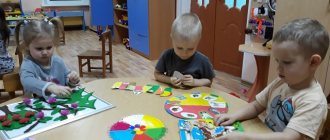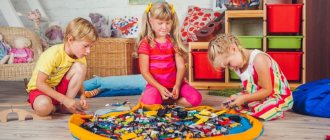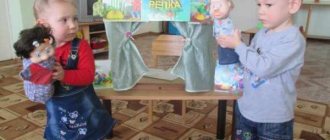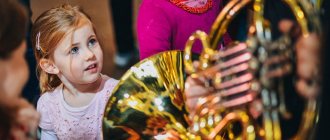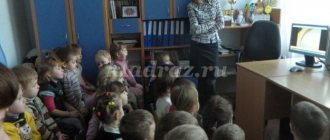Games by theme
Didactic games
For preschoolers (senior and preparatory groups). Games with rules. Board games, card games, lotto, dominoes, construction sets, puzzles, checkers and chess...
Educational games for kids
For young children (junior and middle groups). Development of fine motor skills and coordination, first acquaintance with color, shape and size. Choose by color, screw on the lid, insert a button, braid your hair, games with clothespins, lacing, find a pair, sensory mats and corners, collect beads, felt toys...
Math games
REMP. Formation of ideas about number and quantity, size, shape. Development of spatial orientation, familiarity with time. Count, find the figure, determine the size, logic problems, counting sticks, geocont, tangram, puzzles, geometric lotto, abacus, clock...
Music games
Formation of a sense of rhythm, development of musical perception, familiarity with notes. Musical instruments, homemade noise instruments, games with notes and sounds, musical corners.
Creative games in fine arts
Acquaintance with folk art, artists and paintings. Development of aesthetic perception, color perception, familiarity with the rules of composition. Arts and crafts, patterns and ornaments, palette, drawing games, make a portrait, put together a landscape...
DIY books
Homemade baby books, albums, soft, tactile, lapbooks...
Games on ecology and familiarization with the surrounding world
Consolidating knowledge about natural objects and phenomena, animals and plants. Plants, animals, insects, planet Earth, weather, space, water, sand...
Seasons and calendar
Seasons, months, days of the week, parts of the day, regime and daily routine...
Layouts
Ecological (landscape), traffic regulations, historical, local history, seasonal...
Traffic rules: games, manuals
Traffic rules, signs, traffic lights, cars, street layouts...
Speech therapy games
Development of breathing, articulation, formation of correct sound pronunciation, learning to read and write, sounds, letters. Automation of difficult sounds, exercises with sounds, letters and syllables, vowels and consonants, make up a word, games for breathing development...
Speech development games
Development of coherent speech, grammatical and lexical structure. Based on literary works, based on reference pictures. Mnemonic tables We form adjectives, coordinate words, use prepositions, formulate questions, games based on fairy tales and literary works...
Guides for role-playing games
Attributes and aids for role-playing games, accessories, clothing, furniture
Theater in kindergarten
Do-it-yourself puppet, finger, tabletop and other types of theaters, masks. Theater corners.
Suits
Carnival, theater, dance and other homemade costumes for children and adults
Local history games
Clarification of ideas about the Motherland, native land, its history, the Second World War. Regional component.
Folk, folklore, round dance games
Games of different nations. Games of our grandmothers, our childhood, round dance games.
Games to develop imagination, TRIZ
Invention games. We train analytical thinking, learn to identify, compare, and solve problems.
Psychological games
Development of emotions, communication skills. Games for a good mood, little girls, for dating. Mood corners
Outdoor games
Active games outdoors and at home.
Physical exercises, gymnastics, exercises
Physical exercises, attributes, finger games.
Non-standard equipment for physical education
Sports and physical education corners, equipment for physical education, sports competitions, relay races. Massage paths
Educational games for children 3-4 years old in kindergarten card file (junior group)
Educational games for children 3-4 years old in kindergarten. https://razdeti.ru/razvivayuschie-igry-dlja-detei/…
Games for developing thinking for preschoolers 3-4 years old
Game "Who sleeps where."
Goals: to develop mental abilities, ideas about basic geometric shapes; assign a color name; form selection actions according to the model.
Game material and visual aids: cards divided into sectors (each sector contains a geometric figure).
Description: children remember the names of familiar human figures. The teacher distributes cards showing “beds” for each of the figures. The “little people” must be put to “sleep” in beds suitable for them, that is, all the figures must be laid out on cards so that they coincide with those drawn. For example: a person who has the shape of a square lies down in a crib of the corresponding shape.
Game "Endless classification".
Goal: to develop classification skills, attention, memory.
Game material and visual aids: cards with images of animals and some other objects.
Description: lay out all the cards. Invite your child to separate all the cards with images of animals. Next, animals are divided into wild and domestic. From the domestic ones, in turn, select those who have hooves and sort them into those with horns and those without horns. Animals can be classified according to the following characteristics: fluffy - smooth-haired, predator - herbivore, swims - does not swim, jumps - does not jump, etc.
Game “In the garden, in the vegetable garden...”.
Goals: develop classification skills; help explore the order of things.
Game material and visual aids: cards with images of a vegetable garden, garden, forest; figures of vegetables, fruits, berries, mushrooms (cut out of cardboard).
Description: invite the child to correctly distribute the cut out figures, remembering what grows where: vegetables - in the garden, berries and mushrooms - in the forest, fruits - in the garden.
Game “What should we put in the refrigerator?”
Goals: develop classification skills; help explore the order of things.
Game material and visual aids: cards with images of a refrigerator, wardrobe, china cabinet, bookcase, images of objects stored in the refrigerator, wardrobe, etc.
Description: tell your child a story about how one boy decided to indulge himself: he took out all the food from the refrigerator, clothes from the closet, as well as all the dishes and books. All the things were mixed up, and he could not put them back in place, but the boy’s mother would see and be upset. “Let’s help the child and put everything in its place: food next to the refrigerator, clothes near the wardrobe, books near the bookcase, dishes in front of the cupboard.”
Game "Find the picture".
Goal: to develop memory and attention.
Game material and visual aids: pictures of the same format with different images.
Description: show the child a picture. He must examine it carefully. Invite the child to turn away and lay out all the pictures, including the one previously discussed. Offer to find a picture that he has already seen.
Game "Guess the picture."
Goal: to develop attention, auditory perception, speech.
Description: Post several pictures with different images. For the first lessons, you should choose a drawing with a single subject. Invite the child to choose a picture, but do not say which one. Ask your child questions, the answers to which will lead to a solution. For example: “Does the picture you chose show an animal? Is this a wild or domestic animal? Is it with horns? With hooves? He has a long tail? Etc.". Offer to switch roles: the teacher makes a picture, and the child asks questions.
Game "What am I doing?"
Goal: to develop attention and imagination.
Description: invite the child to play an interesting game: the teacher imitates certain actions, and the child must guess what this means. For example: the teacher folds his fingers as if holding a pencil and moves his hand along an imaginary paper. The child must guess what the teacher is “drawing” or “writing.” You should show simple, understandable gestures (knock with a hammer, eat with a spoon, drink from a cup, throw a ball, etc.). Then switch roles.
Game "Who does it."
Goal: to develop speech, observation, logical thinking.
Description: invite the child to guess who the story is about. List the actions of this or that person. For example: comes home from work, has dinner, plays with you, goes with us to the park, circus, etc. (Mom or Dad.) Cuts hair, does hairstyles, works in a hairdresser. (Hairdresser.) Treats children and adults, wears a white coat, listens with a phonendoscope. (Doctor.)
Game "Who's Got It"?
Goal: to develop speech, attention, memory, observation.
Description: see the game “Who Does It” (objects that evoke associations with human actions are listed). Explain the rules to the child and start listing. For example: who has round brown glasses, a green jacket and a gift for you? (At Grandma's.) Who has a white coat, a phonendoscope, a white cap? (At the doctor.) Etc.
Game “The cow gives...”.
Goal: to develop attention and memory.
Game material and visual aids: cards with images of animals, products obtained from animals (milk, eggs, wool, etc.).
Description: Arrange the cards in random order. Invite the child, next to the image of each animal, to put an image of what this animal gives us. For example: chicken - egg, feathers (you can draw a pillow); cow - milk (cottage cheese, sour cream, kefir); goat - downy yarn (draw socks, mittens), etc.
Game "Narrow - Wide".
Objectives: to introduce the concepts of “narrow - wide”; develop matching skills.
Game material and visual aids: two balls of different sizes.
Description: invite the child to roll balls along a path fenced with cubes. Make two stripes - one for the small ball, the other for the large one. Roll a small ball along a wide path, then try rolling a large ball along a narrow path. Encourage your child to explain why the ball cannot fit on the small track. Introduce the concepts “narrow - wide” into your child’s active vocabulary. Experiment: move toys of different sizes along the paths. At the end of the game, generalize: a wide path is for large toys, a narrow path is for small ones.
Game "Comparison of quantities."
Goal: to develop comparative analysis skills, speech, logical thinking.
Game material and visual aids: wide and narrow strips of paper, cubes.
Description: invite the child to build houses for the mouse and for the bunny: “Do you think we will build them houses of the same size?” Encourage the child to conclude that the mouse’s house should be smaller than the bunny’s house.
After the houses are ready, tell them that the animals asked to put paths in front of their houses for guests. But to prevent guests from getting confused, the path in front of the mouse house should be narrow, and in front of the hare house - wide. Show your child how to determine which of the tracks (paper strips) is wider by placing them on top of each other. Let the child himself distribute the paths between the houses.
Game “How to distinguish them?”
Goal: to develop the skill of comparative analysis of objects by superimposing them on each other.
Game material and visual aids: identical geometric shapes with slight differences in size (cut out of paper).
Description: tell the child that the figures are cakes for dolls. Our scattered dolls mixed up all the cakes and cannot determine which is which. After all, the cake for Masha is larger than the cake for Olya, and the cake for Sveta is the smallest. We need to help the dolls. Let the child think about how this can be done. Show him how, by placing the figures on top of each other, he can figure out which cake is bigger and which is smaller. Give the dolls their dessert.
Game "Pick up a Christmas tree."
Goal: to develop matching skills, the ability to use words “above - below”, speech.
Game material and visual aids: Christmas trees (cut out of paper) of different sizes.
Description: draw a house. Tell your child about the boy who lives in this house. Draw snowdrifts near the house. Explain that New Year is coming soon. This means that you definitely need a Christmas tree: “Help me choose a Christmas tree that will fit in the house.” Place the Christmas trees on another sheet of paper. If the child cannot cope with the task, show him how you can compare the size of a Christmas tree and a house by placing a tree next to it. When placing the Christmas trees, comment: “No, this Christmas tree won’t suit us, it’s taller than the house, it won’t fit there. And this Christmas tree is too small, it’s lower than the house.”
Game “Does this happen?”
Purpose: to help study the category “above - below”.
Description: draw a multi-story house, next to it is a village house of the same size. Ask your child if it is possible for these houses to be the same size in real life? Finding out why this cannot be (many floors - one floor), means that a multi-story house is higher, and a village house is lower.
Game “How are they similar?”
Goal: to develop attention and observation.
Description: show the child two objects, ask him to talk about what these objects have in common, and then how they differ. For example: “Look at a ball and a cube of the same color.” General: both items are toys, both are the same color. Differences: the ball is round, the cube is square, the ball is large, the cube is small. To complicate the game, show the child objects with less pronounced differences, for example: two cars of the same color, but with different wheels, body shape, etc.
Game "Freight Train".
Goal: develop logical thinking.
Game material and visual aids: cards depicting objects of different categories (dishes, furniture, animals).
Description: invite your child to play with the train. Trains go to different cities and carry different goods. For example, a train going to Moscow is carrying dishes. Therefore, the pictures of the trailers should show items of this category. A train going to another city carries wild animals, etc. To complicate the game, lay out cards of different categories, but made of the same material, for example, wooden spoons, wooden chairs, wooden cubes, boards, etc.
Game "Guess what I'm talking about."
Goal: to develop logical thinking, memory, attention.
Description: invite the child to find an object in the room. Describe its location, color, shape, material from which it is made, etc. For example: “What I wished for is now under one of the chairs in this room. This object is small, round, rubber, red.” To complicate the game, in the future do not name the place where the object is located, listing all its other signs.
Game “What Happens...”
Goal: to develop speech, memory, and the skill of generalizing objects by attribute or property.
Description: the teacher asks the child questions, and he answers them. For example: “What is yellow?” (Chicken, sunshine, etc.); “What grows on a tree?”; "Who lives in the forest?" etc.
Game "What is it like?"
Goal: develop comparison skills.
Description: invite your child to play questions and answers. For example: “What is as round as a ball?” (Watermelon, orange, apple, etc.); “What is as white as snow?”; "What's as sweet as sugar?" etc.
Game "Show the path."
Goal: to develop fine motor skills and logical thinking.
Description: draw small images of animals in different places and, at a distance from them, what these animals eat as food. For example, if a hare is drawn on a piece of paper, then there should be a carrot or cabbage, a bear should have a barrel with the inscription “Honey”, a mouse – cheese, etc. Invite the child to draw lines that will show the animal where his favorite food is. You can play in accordance with the themes: “People - clothes”, “Animals - home”, “Tree - leaf”, etc. To complicate the task, draw several trees or flowers in the middle of the leaf, explaining to the child that the path should go around them.
Games for preschool and primary school children
By groups:
- Senior group
- Preparatory group
- Middle group
- Junior group
Showing publications 1-10 of 36016. All sections | Children's games
New
Photo
The best
Game as a means of speech development Game is the leading activity of a child. 1. The game develops communication skills; there is a place for partnership based on respect for the child, even a small one. 2. Cognitive interest develops. It is much easier to teach a child while playing , this is facilitated by...
Financial literacy game “What? Where? When?" for children of senior preschool age Game “What? Where? When?"
for children of senior preschool age Lyungrin Olga Evgenievna Educator of MADOU MO Nyagan,
Kindergarten No. 6 “Rowan”
Tasks: 1. Continue to teach how to play educational
games ; follow the rules of the game ; be reserved; skillfully answer questions...
Children's games - Games and exercises for the development of fine motor skills in preschool children
Publication “Games and exercises for the development of fine motor skills in preschool children...” Games and exercises for the development of fine motor skills in preschool children. It is now known that at the initial stage of life, it is fine motor skills that reflect how a child develops and indicate his intellectual abilities. Children with poorly developed manual motor skills...
Image library "MAAM-pictures"
Play-game “Matryoshka has a housewarming party” (junior group) Target: has an idea of the sights of his hometown; knows how to talk about a holiday in the city. Priority educational area: speech development in the integration of educational areas: “physical development”, “cognitive development”. Technologies,…
Walking game “Travel around your hometown”
Printed board game Journey through the hometown “Kamenka” Goal: to develop in children a sense of love, pride in their small homeland, and attachment to their hometown. Objectives: - To form patriotic feelings. — Expand knowledge about the history of the city, its...
Games to develop in children the ability to coordinate words in a sentence, to correctly use prepositions in speech “Say it correctly” Goal: to teach to coordinate pronouns with nouns and adjectives in meaning. Procedure: Children choose a vegetable or fruit of their choice and stand in one line. The first child says, “This is my apple,” and takes a step forward. The next one says: “This is my cucumber” and...
Children's games - Leisure "Journey to the Land of Winter Games"
Article “Leisure “Journey to the Land of Winter...” PROGRESS OF ENTERTAINMENT Children enter the hall accompanied by a cheerful march and form a line. INTRODUCTORY PART Instructor: Hello dear guys and our valued guests! Today I want to invite you all to the “Land of Winter Games and Entertainment”. But for this you need to take with you a sporty character and...
Master class on making an attribute from a plastic cup and fabric for the game or dance “Ice Cream”
For dancing, as well as for the plot game, ice cream is sometimes necessary. My option is safe and also the most budget-friendly. And so we need a cup, it can be paper, preferably made of thick paper, or plastic, it’s better if it’s a bright, plastic ball made of...
Games and exercises to relieve emotional stress in preschoolers GAMES AND EXERCISES TO RELEASE PSYCHOEMOTIONAL TENSION Everyone knows very well that a person’s mental state and his well-being are closely interconnected. The absence of physical pain gives a person the basis for a positive emotional state. At the same time positive...
Memo for parents “Winter games on a walk” Dear parents! When going for a walk with your child, take different toys with you. These could be shovels, buckets, molds, a toy dump truck, a ball, a sled, skis, or ice cubes. Toys should be plastic so they can be easily washed. Do not take indoor toys outside. In games...
Pages: … 3602
T-shirts, shorts, and what else?
Each kindergarten has its own list of necessary clothes that parents must prepare for being in the group, sleeping and walking. But in general, the lists are very similar, the main rule is: the younger the child, the more spare sets should be stored in his locker.
What if the baby has not yet made friends with the potty? This question worried me very much, since we still have “accidents”. This is not a reason to refuse to attend kindergarten. It’s just that at first the baby will go with “insurance”, but not in the form of a diaper, but in the form of special waterproof panties. He will go potty with all the kids, but if he suddenly misses the moment, the carpet in the group will remain dry.
Clothes for being in a group:
- The biggest “stock” you should prepare is underwear. More panties, a little less T-shirts. You can easily determine the amount yourself, how much does it usually take you per day, how often do you have to change your baby’s clothes? The optimal quantity is at least three sets per day.
- Shorts and skirts in summer, pants and tights in winter. Please note that simple models that the child can put on himself are most suitable.
- T-shirt, T-shirt - in summer, blouse, sweater, turtleneck - in winter. Avoid one-piece overalls; it will be difficult for your baby to use the potty in them.
- Shoes: you will need at least two pairs for a daytime stay in the group; these are ordinary slippers with Velcro, sandals, ballet flats, shoes for girls. Any shoes - only with a back and straps. Czechs can come in handy for dance lessons, yes, even for boys.
- Socks, knee socks - at least three pairs per day, one regular, one spare, one warm - for a walk in the cool season.
- Often, children do not change clothes for naps; they simply remain in T-shirts and panties, but if you wish, you can bring cotton pajamas, especially if it is cool in the group.
Clothes for walking:
- Headgear - depending on the weather, one is enough, do not forget about a panama hat in the summer, and a shirtfront in the winter, it will protect your neck from the wind. Also stock up on at least two sets of mittens, preferably waterproof ones.
- In the warm season - trousers, leggings, jeans, a tracksuit, a knitted set - anything can be, the main thing is that the child does not overheat, but does not freeze.
- A jacket for a walk: it can be very simple and inexpensive, and most importantly not a brand name, so that you don’t have to wash it every day.
- Shoes: also depending on the weather, one seasonal pair of shoes is enough, as well as rubber boots in case of wet weather.
- There is no need for too warm sheepskin coats and felt boots; walks are canceled in cold weather.
A little trick that has become commonplace for experienced mothers, but may not yet be known to “newbies” is to bring your child to kindergarten in “decent” outerwear, and to have a spare jacket and pants ready for a walk. That is, the baby does not risk ruining a good “going out” set, but also does not scare passers-by with his appearance on the way home from the garden.
Clothes for classes and events
Also, a young kindergartener will need a set of festive clothes; you can buy them immediately before a significant date, for example, a themed carnival costume.
For sports activities, a separate set is required; it is not necessary to buy a tracksuit; you can get by with shorts with a T-shirt, or leggings with a T-shirt. But it’s better to buy shoes for sports; they should fix the ankle well and also have good shock absorption.
What should the clothes be like?
Simple, made from natural fabrics, without unnecessary decorative elements. Fastener: linden for shoes, elastic for pants, simple silhouette for blouses without zippers, lacing or buttons. Don't forget to label each item of clothing on the reverse side; you can use the free space on the tags for this.
Development of a child’s thinking in a creative form
Psychologists believe that in preschool age role-playing play is the leading activity leading to the development of the child’s psyche. Trying on the role of an adult causes strong emotional experiences, regulates relationships and influences the development of character and personality. One should also take into account such positive effects on the child as the load on both hemispheres of the brain, which is necessary during lateralization and develops creative and analytical abilities, getting rid of pseudo-concepts and overcoming negativism.
Games for children unobtrusively teach new skills, develop thinking and imagination, and help establish control over behavior. In a playful form, it is easier and more effective to convey information, teach how to concentrate and solve problems. Modeling a variety of activities makes it possible to learn new experiences and acquire original models of individual behavior. The process brings joy and pleasure to the child, he easily gets involved and shows genuine interest, independently understands the tasks and actively searches for answers, tries to cope with difficulties.
Original creative programs will appeal to girls and boys, will help in mastering knowledge and skills, and will bring benefit and variety to learning.
All sections
